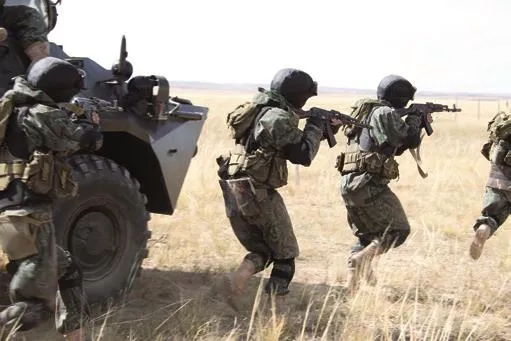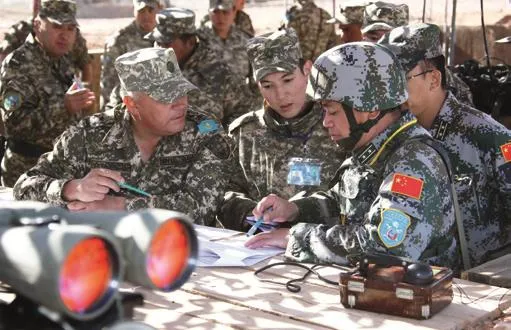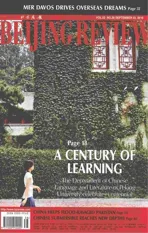Practicing for Peace
2010-09-12ByDINGYING
By DING YING
Practicing for Peace
By DING YING

FORWARD: Kyrgyz special operations soldiers advance during the “Peace Mission 2010” joint antiterror drill on Matybulak Range in Kazakhstan on September 15
The Shanghai Cooperation Organization holds joint military exercises for regional stability
Shanghai Cooperation Organization (SCO) members have been holding joint military exercises since 2003. And this year’s was called “Peace Mission 2010.”
Analysts say the exercises, aimed at striking the “three evil forces” of extremism, separatism and terrorism in Central Asia, now play an important role in maintaining regional peace and stability, and will beneft the whole region and beyond.
Highlights
This year’s drill was the seventh antiterrorism military exercise under the SCO framework. In total, about 5,000 troops—China, Russia, Kazakhstan, Kyrgyzstan and Tajikistan each dispatched around 1,000—participated in the drill in Kazakhstan from September 10 to 25. The exercise was divided into three phases: strategic consultation, joint antiterror battle preparation and joint antiterror battle implementation.
“This year’s drill differed from the previous six in scale, distance and duration,” Feng Changhong, a senior research fellow with the Academy of Military Sciences of the People’s Liberation Army (PLA), said to Beijing Review. He pointed out that the drill had drawn the most troops of SCO antiterror exercises, even without Uzbekistan’s participation.
Chen Jianmin, also a research fellow with the PLA’s Academy of Military Sciences, said as mutual trust and cooperation in political, economic and military aspects strengthen under the SCO framework, the organization’s joint antiterror military exercise system is maturing. SCO members now have strong desires to attend joint drills, he told China News Service.
The PLA dispatched 1,000 troops to this year’s exercise, including a ground force combat group, an air force combat group and a logistics group. The troops traveled more than 5,000 km to get to the drill site in Kazakhstan; this was a big test for the PLA’s comprehensive transportation capability. The exercise lasted 15 days—the longest one ever, Feng said, adding that this was also the frst time that China dispatched three different groups.
The real highlight was the participation of sophisticated weapons, like China’s J-10 fighter and H-6 bomber, Feng noted. Although these are conventional PLA weapons, “Peace Mission 2010” was the first overseas drill for them.
In regular drills, the H-6 bomber has hit its target 100 percent of the time, which is an impressive feat, he said. Also, China’s helicopters have demonstrated the ability to operate at extremely low levels—only 40 meters off the ground in a valley—which is a big challenge to pilots’ skill.
Chen also pointed out that some new types of antiterror equipment appeared during the drill. In recent years, Russia has upgraded its weaponry with smaller, mechanized types, and these weapons were tested in the practical battle environment.
The real highlight was the participation of sophisticated weapons, like China’s J-10 fighter and H-6 bomber
Li Shuyin, who is also from the PLA’sAcademy of Military Sciences, said that this year’s drill refected high mutual trust among SCO members, because Kazakhstan, the host nation, allowed foreign air forces to fy from their home countries to Kazakhstan to participate in the drill without stopping.

JOINT MISSION: Chinese and Kazak officers discuss training plans during the “Peace Mission 2010” joint antiterror drill on Matybulak Range in Kazakhstan on September 14
The SCO stands for mutual respect and seeks common ground while shelving differences, which can be read from this year’s drill too, said Li. Although SCO members have different economic, social and natural conditions, they dispatched equal numbers of troops to the drill and participated equally in the strategic consultations. The equality of its members would add to the solidarity of this organization, Li said.
Significance
Many Western analysts wondered whether the SCO is a regional military alliance, especially since it has held seven joint drills since 2003. But Chinese experts say the SCO is defnitely not a military alliance, as indicated by the goals and name of the drills.
“The SCO is certainly not a military alliance. It is an organization established for regional cooperation,” Feng said, noting that it is different from military alliances, such as NATO, because it does not have a military alliance treaty.
Moreover, China always stresses non-alignment in its foreign policy. The organization doesn’t target any other countries, Feng said.
Chen Bingde, Chief of the General Staff of the PLA, said the drills were important in implementing the consensus reached by the heads of state of SCO countries. They signifcantly contributed to the countries’ efforts to eliminate the “three evil forces,” promote regional security and deepen SCO-wide cooperation, he said.
The “three evil forces” are threats to the international community, and Central Asia is an area that is home to many terrorist forces. The drills were mainly aimed at calming regional crises triggered by the “three evil forces,” said Feng. Since 2007, they have been labeled as “peace mission,” a name that also refects their goals.
By launching joint military drills under the SCO framework, SCO countries can beneft in both military and political aspects, Feng said. From the military point of view, joint military exercises help improve antiterror battle command, coordination, logistics and operation methods. Politically, joint exercises, which represent the highest level of military cooperation, help strengthen international military cooperation.
For China, the drills offer opportunities to showcase the PLA as a defender of peace on an international stage, he said. They help enhance the PLA’s military transparency, promote its coordination ability with foreign military forces and improve its competence by learning from the military forces of other countries.
Chen Jianmin said the drills can make the SCO and its members more capable of coping with non-traditional security threats. Other SCO members, including China, can learn a lot from Russia on controlling terrorism, he said. Since the Cold War, Russia has had a good deal of practical experience fghting terror, maintaining stability and dealing with terrorist attacks.
He believes that, in addition to training troops and promoting communication with foreign troops on military training and military theories, the drills were also a chance to demonstrate the PLA’s open attitude toward the world. “China is an active participant in these SCO antiterror drills,” he said.
A stable and peaceful Central Asia will benefit all nations in the region, said Chen Yurong, a research fellow with the China Institute of International Studies. For example, peace and stability in Central Asia are of great signifcance to the economic development in China’s western region.
In addition to deepening security cooperation, promoting economic development and prosperity of its members is also at the top of the SCO’s agenda, she said. The military exercises can deter the “three evil forces” in the region and help create a peaceful environment for political and social stability in Central Asia.
